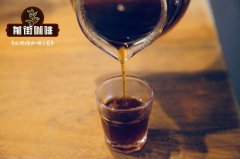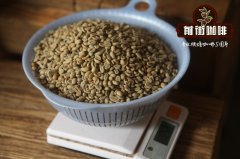What is honey-treated Honey Processing? Effect of honey treatment on bean flavor?
What is honey-treated Honey Processing? Effect of honey treatment on bean flavor?

In the honey treatment method, "honey" means that the coffee bean is as sticky as honey (mucilage). The sun method will directly remove the shell and the pectin layer, while the water washing method will remove the pectin layer by fermentation, and only the honey treatment will retain the pectin layer.
Honey treatment will remove the outer pulp of coffee beans, retain the sticky pectin layer (mucilage), this layer of pectin is very sticky and slippery, sugar is very high and acidic, coffee beans with pectin layer will be exposed to the sun, coffee farmers need to turn coffee beans frequently to avoid mildew, exposure time is too short and unable to transfer the substances of the pectin layer to coffee beans, timing and moisture control are very important.
Honey treatment is more time-consuming and troublesome than washing and tanning, and requires more manpower and time, so why choose this method? The answer obviously has something to do with better coffee products. honey-treated coffee beans can preserve the original sweet flavor of coffee ripe fruit, balance sour and sweet taste, and have a more mellow taste.
Have you noticed that the coffee beans treated with honey are subdivided into yellow honey, red honey and black honey? It depends on the degree of retention of the pectin layer, with 80% called black honey, 60% red honey, 40% yellow honey and 20% white honey, showing different flavors.
Huang (Honey Amarillo)
The light time of raw coffee beans treated with yellow honey was the longest. Longer light means higher heat, so the coffee can be dried within a week. In general, the drying time of coffee depends on the local climate, temperature and humidity.
Red (Honey Rojo)
The drying time of raw coffee beans treated with red honey is 2-3 weeks, usually due to weather or placed in a dark place. If the weather is clear, the grower will shade part of the sun to reduce the sunlight time.
Black (Honey Negro)
Black honey treated coffee beans dried in the dark for the longest time, the shorter the light time, the drying time for at least 2 weeks. The black honey treatment of raw coffee beans is the most complex (because of the longer drying time, it takes longer to check to prevent the coffee beans from mildew and fermentation), the labor cost is the highest, so it is the most expensive.
On the palate, in addition to the above-mentioned sweetness, yellow honey is close to the clearness and purity of washing, while black honey is close to the rich fruit aroma and rich texture of sunburn, with red honey in the middle. Of course, this is only a common description of the flavor. The degree of baking, the way of cooking and the terroir (local conditions or microclimate) where different estates are located will still produce differences in taste. Just wait for you to taste it carefully.
The processing method of honey treatment enriches the uniqueness and unpredictable complexity of coffee flavor compared with water washing treatment. This is not to say that honey processing is better than washing processing. For example, in producing areas such as Rwanda and Sumatra, traditional local processing methods lead to the uniqueness of coffee flavor. Delicate honey treatment may also create a different flavor of coffee in the past. The specific situation in Brazil is different, as mentioned earlier in this article, people have been using terms such as "sun treatment" or "drying treatment" in Brazil. Compared with the traditional full-sun Brazilian coffee, the exquisite Brazilian honey-treated coffee does not get the corresponding attention of the world. Brazilian honey-treated coffee has a brighter and finer flavor, with more floral and fruit aromas than the traditional Brazilian sun-cured nut chocolate flavor.
Important Notice :
前街咖啡 FrontStreet Coffee has moved to new addredd:
FrontStreet Coffee Address: 315,Donghua East Road,GuangZhou
Tel:020 38364473
- Prev

Indonesia West Java Aimani Manor Single Bean Type Manor Honey Treatment Coffee Brewing Parameters Introduction
Sumatra has three main growing areas: the northern part of Aceh, the area slightly south around Lake Toba, and more recently the islands around Mangkuraja. It may also be traced to smaller areas of Takengon, Bener Mariah in Aceh, L.
- Next

What is Kenya AA? On the grading system of Kenyan Coffee
Related
- Detailed explanation of Jadeite planting Land in Panamanian Jadeite Manor introduction to the grading system of Jadeite competitive bidding, Red bid, Green bid and Rose Summer
- Story of Coffee planting in Brenka region of Costa Rica Stonehenge Manor anaerobic heavy honey treatment of flavor mouth
- What's on the barrel of Blue Mountain Coffee beans?
- Can American coffee also pull flowers? How to use hot American style to pull out a good-looking pattern?
- Can you make a cold extract with coffee beans? What is the right proportion for cold-extracted coffee formula?
- Indonesian PWN Gold Mandrine Coffee Origin Features Flavor How to Chong? Mandolin coffee is American.
- A brief introduction to the flavor characteristics of Brazilian yellow bourbon coffee beans
- What is the effect of different water quality on the flavor of cold-extracted coffee? What kind of water is best for brewing coffee?
- Why do you think of Rose Summer whenever you mention Panamanian coffee?
- Introduction to the characteristics of authentic blue mountain coffee bean producing areas? What is the CIB Coffee Authority in Jamaica?

